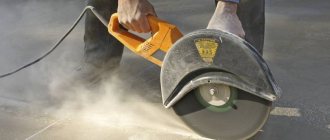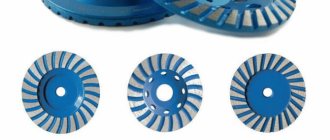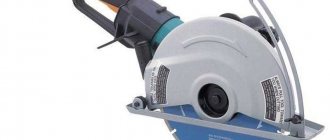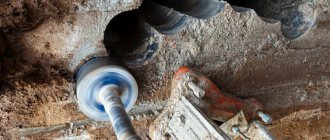Beton-House.com
Website about concrete: construction, characteristics, design. We combine the experience of professionals and private craftsmen in one place
Using a grinder when cutting concrete
Today it is difficult to imagine doing the work of mechanics or builders, repairmen and other similar professions without an angle grinder. It is actively used when cutting, trimming and grinding various materials.
As the number of attachments increases, its functions become more diverse. The article suggests getting to know how concrete is cut with a grinder and its features.
- Cutting concrete along a line
Preliminary activities
Sanding is getting rid of minor defects, so before starting the process you will have to take care of getting rid of major defects:
- These are different types of tubercles. If it is visible to the eye, then it is better to cut it off with a grinder. The maximum permissible tubercle size is 1 mm.
- Seams. There should be no visible seams. No amount of sanding can get rid of a seam or dent on a screed. In this case, you will have to fill it again or pour an additional layer on top.
- Depressions. It is better to cover up the depressions. There should be no visible cracks, depressions, or dents.
- Mark the areas where you will have to sand a little longer, i.e. unevenness of the screed itself. To do this you need to use a level.
- After this, you need to check the voltage in the network. A sudden jump or fall can cause the grinder to malfunction, the grinding to break, and the hand to tremble. Because of this, it may be necessary to create the floor from scratch.
- The floor itself needs to be tested for strength. To do this, you will have to make a test run with a grinding machine. If the floor crumbles too much, you need to use a nozzle with a smaller grain size or refill the floor.
It is very important to use crushed stone of small fractions when pouring, since no discs are enough to polish a large stone, which will certainly end up in the most inappropriate place for this.
If a small but visible crack has formed, then use a diamond disc to widen the crack and seal it flush with the floor level. You can start sanding only after such seals have dried.
The expansion is carried out to a depth of 10 cm, after which a piece of concrete is removed, the surface is treated with a primer and only after that a sealing layer is applied.
Technology and stages of the grinding process with an angle grinder
- Preparation: cleaning surfaces, marking sanding, sealing seams, sawing off protrusions, etc. Be sure to remove all debris before sanding, since this will be extremely difficult to do during work. Nothing should distract you from your work. You need to put the casing on the grinder in advance, as well as turn on and prepare the vacuum cleaner. The attachment of the attachments to the grinder is checked.
- Rough grinding. Rough grinding is carried out 3-5 days after the screed is sealed. It is necessary to remove 2.5-3 cm to get rid of the most severe blemishes, cracks and protrusions. After checking the tool, grinding is performed. The 15-minute rule applies to an angle grinder: work is carried out for 15 minutes, after which the tool turns off. You can turn on the grinder again only after the disc has completely cooled down. The heating temperature of the nozzle should not be felt at all. That is, the disk will reach a temperature approximately equal to the ambient temperature.
- The next step is impregnation. Special construction impregnations are used to strengthen concrete. The impregnation is literally poured onto the surface of the screed and slightly leveled over its surface. The concrete will absorb this composition for another 10-15 days. The amount of impregnation is calculated in advance. Do not be surprised if immediately after pouring some liquid remains above the surface of the concrete. Over time, the concrete will absorb it too.
- Only after this is the final processing carried out. To do this, take a thinner disk with a higher abrasive value. If a disk with an abrasive of 25 is used for rough processing, then for the final one you will have to use a nozzle with an index of 40. The glossy effect is revealed only when using tools with an abrasive of 1400-1500.
How to grind concrete with a grinder
Sanding the floor is not so difficult. The main thing is to be careful when correcting rough defects, follow safety rules and choose the right tools.
Working with a hammer drill
For gating with a hammer drill, a special blade-shaped attachment is used. This attachment creates a narrow track that is exactly what you want to achieve.
The part is placed only along the drawn lines, since with a transverse arrangement there is a high probability that an extra piece will break off from the base. In areas reserved for the installation of sockets, use a bayonet attachment, which is used to mark the desired recess, and then expand it again with a spatula.
Grooving for wiring with a hammer drill
There is another way of gating with this unit. The process will require a regular round drill from 6 to 100 mm in diameter. First, a chain of holes is drilled along the line of movement in small increments, literally 1-2 cm. Then they change the nozzle to a spatula, turn on the breaker mode, place it at the very beginning and remove the space that holds the holes together. In the same way, prepare empty space for sockets or switches.
This approach allows you to make a groove with minimal risk of excess chipping, but the edges of the recess turn out to be very uneven. Hand sanding will be required.
It is possible to make the depth in accordance with SNiP if you attach a limiter or wind electrical tape at the required distance from the tip of the drill.
How to Cut Concrete with a Grinder Without Dust
During repairs or construction, it is necessary to carry out concrete work: cut an opening for a window, a niche, tap walls for wiring. Masters understand how many small particles appear in all this. Cleaning up after similar events is a very labor-intensive task. We propose to find out whether it is possible to cut concrete without dust and how to organize the process.
Concrete is a strong material, so working with a child is quite difficult. To perform cutting, in most cases they use an angle grinder (angle grinder). myth the instrument is not just known in everyday life as a “grinder”.
A diamond wheel is used for the nozzle. Depending on the design features, they are divided into several types:
- segmental,
- solid;
- combined (turbocharged).
The first option is a solid base with a segmented edge. Such a circle has a low price; unfortunately, it is not very suitable for working with strong materials. It is also necessary to take into account that it is used only for dry cutting. The solid blade has a continuous diamond edge, so no chipping occurs during operation. This nozzle heats up quickly, so it needs to be cooled with a continuous stream of water.
The combined turbo-diamond disc, as it is also called, is universal. It can withstand critical loads and is even suitable for cutting reinforced concrete.
Before purchasing a suitable type of nozzle, you need to figure out what material you will have to work with. Reinforced concrete is reinforced with metal rods, which the cutter can bump into during the flow. If a recess of more than 10 cm is implied, high-strength discs should be used, in other words, turbocharged ones. Fresh concrete is more abrasive; over time, the material hardens and its strength increases. The myth factor should also be taken into account when choosing a cutting wheel.
The disc segments are attached to the blade using silver solder or laser welding. Option 1 is more suitable for moistened cutting, Option 2 is used only for dry cutting.
When choosing a suitable diamond wheel, pay attention to its diameter, which should match the characteristics of the angle grinder. A fundamental aspect is also the disk rotation speed
It is better if it is higher than the very probable indicator stated in the technical properties of the “grinder”. This will ensure better performance.
The introduction of water allows you to cut concrete with a grinder without dust and overheating of the tool. The development allows you to immediately solve several problems:
- increase the resource of the diamond attachment,
- avoid dust formation,
- increase work speed.
One of the methods to ensure a continuous supply of water is to secure the hose in such a way that the liquid gets onto the disk. If there is no running water in the work area, you can involve an assistant in the process. He will use a simple device made from a plastic bottle to wet the circle. Immediately moisten the incision site with liquid.
This must be done carefully so that water does not pour into the instrument.
The method is not very applicable in high-rise buildings, since there is a risk of flooding the neighbors below.
An angle grinder with an integrated vacuum cleaner allows you to get rid of small particles of material formed during cutting with an angle grinder. But what should you do if you need to cut concrete using ordinary equipment without additional options? The most common solution would be to purchase a housing for the vacuum cleaner separately or make a device at home. Of course, involve an assistant who will collect the particles formed during cutting with a vacuum cleaner.
You can make a comfortable nozzle from an ordinary plastic canister, when they often sell “anti-freeze” cars. To carry out the work, you will need a construction cutter and a container of a suitable size, the neck of which will fit the diameter of the vacuum cleaner hose.
The production sequence is as follows:
- Fitting dimensions are cut out on both sides so you can simply change the direction of rotation of the disk.
- A slot of suitable size is made under the circle.
- To attach the grinder cutter, another hole is cut.
- The hose is connected to the neck of the canister and secured with an adapter ring with a clamp.
- The “grinder” is placed in the casing and the elements are connected to our client.
- The unused hole is covered with a lid.
It is important to know
Modern manufacturers offer a variety of equipment models, so finding a specific model of equipment in Moscow and the regions will not be difficult (as well as companies or specialists who will quickly and efficiently complete the work). But you need to remember some nuances.
Things to remember when cutting concrete:
- Wall saws are not used in multi-storey panel buildings due to the risk of flooding the lower floors with water. The machine is also not suitable for working in confined spaces and when it is necessary to perform small volumes of cutting.
- To reduce noise, you can cut openings in parts (at least 6 parts). The price of the work in this case increases and depends on the number of pieces cut out.
- All holes/openings in load-bearing structures are made only by certified companies and in strict accordance with the rules.
- Legalization of hatches/openings in load-bearing walls requires contacting government agencies with a full package of documents.
Cutting concrete without dust is a difficult task, which can only be partially realized. It is very difficult to completely get rid of dust, but its amount can be significantly reduced through the correct choice of equipment and attachments, cutting method, as well as the use of a construction vacuum cleaner and the creation of special devices for collecting dust.
How to grind with a grinder
We must not forget that sanding always involves a lot of dust. When preparing for sanding, don't forget about yourself! A protective mask and respirator are the best assistants when grinding. You can also find an option where the mask is combined with a good respirator.
The respirator filter will clog very quickly, so you need to prepare several pieces at once for prompt replacement. Only after thorough preparatory work can you begin sanding.
Sanding wood + (Video)
Wood is a unique material. It can be sanded quite well by hand, but with a grinder you can achieve very good results. Some snobs claim that you can’t grind with a grinder at all, but this is due to ignorance and inability.
The main secret is that the grinder is used at minimum speed. If the grinder has a speed switch, then there will be no problems. At high speeds, the sandpaper will become clogged with wood very quickly and very tightly. In this mode, it will not be enough for even five minutes of work. The optimal speed is no more than 6000 rpm.
Another secret is not to sand the entire area of the wheel. If you sand the entire surface, circular marks will remain on the wood. To ensure that there are no sandpaper marks left at all or that they are minimal, you need to sand only with the upper sector of the wheel. The movements of the machine should be along the grain of the wood.
Using this method you can get excellent results when sanding lining. The board becomes smooth and does not retain tool marks. Just don’t get carried away and change the sanding pads on the wheel in time.
The frame is polished in a similar way. Here it is desirable that the support plate is thin around the edge. With such a plate it will be easier to sand narrow junctions of logs. Otherwise, this work will have to be completed with a chisel.
https://youtube.com/watch?v=6HqSS8Wk9Bo
We work on concrete + (Video)
If you were unable to purchase a branded protective boot with a nozzle for a vacuum cleaner, then you can make it yourself. To do this, take a used putty or glue bucket with a diameter slightly larger than the circle of the grinder. We cut off the bottom part at a height slightly higher than the assembled sanding part.
We cut a hole in the bottom for installation on the gearbox and a hole for the plastic plumbing corner outlet. Now we connect the vacuum cleaner hose to the nozzle and work quietly.
The grinding wheel must be designed for stone processing. It is preferable to grind concrete and concrete surfaces using the entire surface of the wheel. This will save processing time and level the surface well.
When grinding a concrete floor, you must constantly control the plane using a construction ruler, because due to the different densities of concrete, indentations can be made. To process the joints between concrete pours, it will be sufficient to achieve one level combination.
It is good to grind concrete floors and surfaces with a Matrix diamond grinding cup. If the grinder is 150 mm, then the cup is 125 mm.
Grinding metal surfaces + (Video)
The metal is polished to different requirements. Most often, the metal is ground for painting or for further polishing. The main tool is a support cup with replaceable sanding pads. The selection of sandpaper depends on the degree of processing and the condition of the metal.
When sanding, you only need to work with part of the disc. There should be no untreated areas left on the surface.
It is advisable to coat the treated surfaces of ordinary steel with a primer. Moisture in the air can very quickly coat the metal and cause rust.
https://youtube.com/watch?v=73nuIaCKLRQ
Safety precautions
To minimize the risk of injury, you must adhere to the following rules:
- Be sure to use protective equipment: goggles or a protective mask, gloves, closed shoes and clothing, a respirator.
- It is forbidden to work with a grinding machine without a protective metal casing.
- Always monitor the location of the electrical cable to ensure that it does not get caught under the cutting part.
- Hold the tool with both hands and stand parallel to the rotating circle. This way, if the disc jams, the tool will be thrown past you.
- The forward movements of the grinder must coincide with the direction of rotation of the disc.
- To control a safe cut, immerse the cutting part by one third of the radius of the cutting wheel.
- For each material, use the appropriate disk: for metal, stone, dry cutters, grinding disk. Each tool has its own direct purpose.
- Be especially careful when operating both at extremely low and extremely high speeds.
- Do not immerse the cutting part in water to avoid dust formation: there is a high risk of short-circuiting and electric shock to the worker.
- Work only in a well-ventilated area or outdoors, but avoid working in the rain.
Tool selection factors
You can't do it without using a special sawing tool. When choosing it, it is necessary to take into account a number of factors:
- The location of the structure and its dimensions. For thick walls and concrete floor screed, different tools will be used even with the same properties and composition of the stone.
- The composition matters: the harder the filler, the more difficult the cutting. Granite crushed stone, one of the hardest, or crumbs of softer stones can be used as a coarse aggregate. You should evaluate the quality and size of the sand - the finer it is, the denser the concrete. Large unwashed stone creates a looser stone structure.
- Age and condition of structures. The peculiarity of concrete is that it gains strength over the years. Cement, which makes up the bulk of the composition, only adds strength when absorbing moisture. In combination with fine sand, such a stone becomes very hard. However, dilapidated structures that are exposed to chemical environments lose their former strength and hardness.
Briefly about the main thing
Before carrying out masonry work, you need to clearly decide whether it is more profitable to cut bricks than to cut them. Such work can increase the estimated cost and lead to unnecessary expenses. When constructing an interior partition, you can use the simplest and oldest method of cutting brick - cutting stone. It will save time, effort and money. To cut out shaped elements, a miter saw with a diamond blade will come to the rescue.
For small construction, for example, a bathhouse or a garage, you can get by with a grinder with a diamond blade. It will significantly speed up the work and allow you to complete the laying more accurately. If you cut through a thin wall, it will also come to the rescue.
If you are planning a more full-scale project, such as building a house, then it is best to purchase a specialized machine.
If it is necessary to make an arch, through cuts in already erected wall structures, and even reinforced ones, then you cannot do without a gas cutter (for a small amount of work) and laser cutting (for large-scale projects).
Preparing the workplace
To work with concrete products, you need to choose a place remote from residential premises. It must be remembered that in addition to the unbearable sound, sawing concrete is accompanied by the release of a huge amount of dust, which is dangerous not only for humans and pets, but also for household appliances and furniture. It is advisable to coordinate your activity with your neighbors, who are not always happy about such events in the immediate vicinity of their home. If cutting is done in an apartment or house, you must take care to protect the interior elements with fabric, thick paper or plastic film.
Finishing movements
After the main groove has been laid, the recess is thoroughly cleaned of debris using a brush or a clean paint brush. If necessary, the edges of the cut lines are sanded until smooth.
Now you need to seal the recess to the same level as the main surface.
The recess is primed in two layers, leaving each to dry completely for 10-12 hours. You can, of course, skip this stage, but then cracks will almost certainly gradually appear - without adhesion, the putty will fall off.
The primer will provide the necessary level of adhesion, and putty is used as a filler. Use a spatula to scoop up a small amount of solution, apply the tool forcefully to the wall and move it to the side.
Closing the wiring
You can complete the sealing in several steps, gradually increasing the void, but then you need to think about what and how to compact the putty.
When the solution is completely dry, the wall is sanded with abrasive paper manually or using a sanding machine.
Then it is enough to cover everything together with the rest of the surface with a primer to begin the cosmetic finishing of the room.
Attachments and discs for concrete for grinders
Each tool used in conjunction with an angle grinder (angle grinder) is designed to perform the operations for which it is designed. The correct choice contributes to efficient and safe work with discs and attachments.
Cutting discs
Diamond cutting wheels are used to work with concrete. These are discs made of durable hardened steel with diamond coating on the cutting part.
These nozzles differ in the following design features:
- Cutting edge. It can be solid or with various slots. Segmentation increases the efficiency of air cooling during operation.
- The grain size of the diamond coating and the spraying method. The most reliable methods using laser welding and thermal bonding. Silver soldering allows operation with water cooling only. The electroplated diamond edge cuts only soft natural stones.
- The outer diameter of the circle. The correct size disks must be installed. Working without a protective cover is not only dangerous: the increased size of the nozzle leads to premature wear of the gearbox.
Diamond cutting can only cut material in a straight line. Curved sawing increases the load on the cutting edge, causing the diamonds to break.
Grinding discs for concrete
Concrete is ground to eliminate coating defects. Diamond wheels are used, which have a high abrasive ability and a long working life. Sometimes hard-alloy coated disks, the characteristics of which are lower, are called diamond. The efficiency of work is determined largely by the grain size of the working surface.
Depending on the concentration of diamonds, discs for grinding concrete are distinguished:
- grain size 40-80 (for pre-treatment);
- indicators 100-120 (for leveling the surface);
- grit 180-240 (for polishing).
The tool is a steel circle with soldered segments. Diamond powder is fixed to them with a special bond. It keeps the diamonds from being destroyed by the centrifugal force that occurs during rotation.
The designations on the discs consist of 2 or 3 numbers. The first number indicates the outer diameter, the second indicates the size of the mounting hole. The third number is not always present; it indicates thickness. For a grinding tool, this parameter does not play a big role.
Cleaning and roughening attachments
These attachments look like cups or circles. There are cutters and diamond discs. Twisted metal brushes are located around the circumference of the rollers. They strip metal and stone. The diameter of the wire varies depending on the purpose (scraping or stripping).
Purpose of an angle grinder
The peculiarity of the machine is its ability to process not only smooth surfaces, but also chamfers. This is achieved thanks to the angular placement of the working disk.
The device is universal and can be used to perform many jobs:
- The main operation for which an angle grinder is intended is grinding. Wide grinding wheels are used. Processing the ends with an eccentric grinder is difficult, but it is accessible for an angle grinder. The surface is ground with or without water cooling.
- Polishing with a grinder is also possible. To do this, use special diamond-coated polishing discs.
- Another operation that is performed with a grinder is res. The unit is not suitable for working with thick materials. Concrete or thick stone should be cut with special machines that have a water-cooled working wheel.
- An angle grinder easily cleans surfaces, removing dirt, paint, mastics, adhesives, and construction mixtures using abrasive attachments.
A grinder can be used instead of a wall chaser. A cutting disc is used to cut grooves for electrical cables and pipelines.
Tips for Clean Work
Professional builders use construction vacuum cleaners when cutting walls for wiring. Noisy units that cope with the task quite well. True, after using an angle grinder, even such a device will not completely cope with the dirt.
Purchasing such a vacuum cleaner for domestic purposes is not justified, since the device is expensive. Then some tricks from experienced craftsmen come to the rescue.
Cutting through concrete is fraught with clouds of dust, but they can be minimized if you water the cutting area with clean water from a hose. We must not forget that wet concrete is more difficult to cut through, and the risk that the tool will break off increases, so you need to do everything extremely carefully, holding the device firmly.
You can do without a hose if you have an assistant who will water the disk and the wall from a bottle. It will take a lot of attention and care to ensure that liquid does not get inside the instrument.
You can reduce the scale of contamination by covering the floor with a thick polyethylene sheet. Doorways are covered with thick fabric, even if the door is closed very tightly: dust will still penetrate, and the fabric will greatly reduce the removal of dirt. A wet door mat is placed in front of the door.
As a last resort, wiring can be done completely without dust, but also without gating. Stores have a sufficient assortment of cable channels and other masking devices that can become an additional decoration for the interior.
If you have the skills to handle a miter saw, you can try to make side casings, like those of a wall chaser, yourself, as in the following video:
Shape and number of segments
The quality of the work performed depends on the type and number of segments. There are cups for roughing, rough grinding and for fine polishing of surfaces. According to the shape of the cutters, the nozzles are classified into the following types:
- With double segment
- Square
- Boomerang
- Turbo
- Typhoon
The design of each type provides for a specific arrangement of segments, which affects its operating properties.
The Double Segment Diamond Cup is a two-row tool for eliminating large defects in concrete products. Large beads or protruding seams can be easily sanded with this attachment with a good abrasive effect. Segments arranged in a circle in two rows quickly and efficiently process stone or sandstone. Sometimes builders use a nozzle to reduce a thick layer of screed. But with the help of the “Double Segment” it is impossible to achieve ideal smoothness; the screed becomes rough, so for finishing sanding you need to use a different attachment.
Boomerang
The tool received its name due to the similarity of the shape of the diamond segments to a boomerang. The tool is used for finishing concrete grinding, since the cutters use fine-grained diamond chips. After processing, the screed becomes perfectly smooth. The small weight of the “Boomerang” makes it easy to use; it is often installed on an angle grinder because it is light in weight. The popularity of this type of cup is due to its high productivity, which is almost twice that of other types of diamond blades. The choice of this particular tool is also influenced by its lightness and stability.
Square
Diamond cups “Square” are used for roughening concrete surfaces. The effectiveness of the tool allows it to be used to remove large sagging and protruding seams. Diamond cutters are made in the form of squares. The increased thickness of the working segments and the large distance between them make it possible not only to level the surface with roughness, but also to remove any protruding parts on the concrete. Therefore, grinding with the “Square” attachment reduces the time for rough processing of concrete and brick coatings, extending the life of the diamond segments.
“Square” have a lot of weight, making it possible to process the material with a tool without much effort.
After passing through the diamond cup, the surface remains rough, which gives it high adhesive properties.
This is especially important for adhesion to applied coatings, especially polymer ones
Turbo and Typhoon
The diamond cutters of these attachments are located in a circle on the working surface perpendicular to the direction of rotation. The minimum distance between them creates an almost continuous ring. The appearance of “Turbo” and “Typhoon” disks resembles corrugated fabric. Many segments smoothly polish the surface, so the products are used for finishing grinding on small areas and for shaped stone processing. Using attachments, you can chamfer and form edges, as well as polish small curves on workpieces.
To perform small operations, you can purchase “Turbo” and “Typhoon” cups of small diameter – from 100 mm. The discs are characterized by wear resistance, high productivity and precision processing.
Professional circles
For production purposes, professional diamond wheels with diameters from 125 to 350 millimeters are used. Their cost is significantly higher than the price of similar household cutting tools, but their very high wear resistance and excellent quality of abrasive coating ultimately make them more profitable for regular use.
The high price of professional discs is justified due to their high durability. Products from Distar and Bosch have excellent performance, but the price for one such circle with a transverse size of 230 mm is more than 2,600 rubles.
Classification of professional diamond blades by purpose:
- cutting reinforced concrete;
- making carvings on a concrete base;
- cutting marble, ceramics, granite massifs.
It is very important to understand that if the purpose of professional tools does not correspond to the purposes of use, they will wear out very quickly, and ultimately the costs of performing the work will increase.
Grinding accessories
The key to good grinding is a high-quality and correctly selected abrasive element according to the type of surface being processed.
Disc attachments for grinding
Disc grinders for grinding concrete are the most popular. Depending on the degree of processing, they are of two types:
turtles. This type is suitable for fine finishing of surfaces. They are distinguished by a flexible base, on which fine diamond chips with the addition of polymers are applied. They are quite convenient to use and quick to replace, thanks to their Velcro fastening system;
Cups
Concrete sanding cups of various sizes are a type of grinding wheel used to remove thicker layers of concrete. Depending on the level of processing, the types of cups differ:
- double segment – for removing the first thick layer;
- square. If you need to remove large pieces of concrete during the roughing process, then it is best to use this bowl. It allows you to shoot decent segments without losing the quality of both the coating itself and the nozzle;
- boomerang – provides more delicate grinding of the finishing layer due to fine abrasiveness.
Wetting
The simplest, most affordable option to carry out dust-free work is wetting. That is, the surface that you have to work with - brick, concrete, etc. - needs to be moistened before work. Moreover, there is no need to use something large, bulky, professional - a regular spray bottle is suitable for this purpose. In its absence - a plastic bottle with holes made in the lid. Flowers used to be watered with this device, creating a kind of watering can. Or even a children's water pistol.
The essence of the method is that it is necessary to spray immediately before work, so that the dust gets wet and cannot fly away. And since a person by nature has two hands, he will definitely need an assistant. After all, he will work as an angle grinder. Therefore, a tandem of two people is an ideal option for this work. The only inconvenience: instead of dust, dirty slurry will appear. This is worth remembering.
Wall gating process
You can use a variety of tools and methods to create grooves inside the wall. They depend on the properties of the material from which the building is made. During all work, safety rules must be followed.
Walls can be tiled:
Working with a hammer and chisel
The easiest way to use this method is to treat brick walls covered with a layer of plaster. The top layer in them can even be knocked down with a chisel or chisel. They try to select the places where the vertical grooves will pass at the joints of the seams of alternating rows so as to make fewer cuts in the remaining bricks. When the plaster coating layer is of considerable thickness, then furrows can be made using this method without damaging the brickwork. In other materials, especially concrete, these tools are very difficult to use.
The knockout process involves placing a chisel with the sharp end along a line and applying a hammer blow to knock out a piece of putty or brick. First, the surface layer is removed in a small section. Then the chisel blade is placed across the line and at an acute angle to the wall - the grooves are deepened.
Working with a hammer drill or impact drill
First, you will need to drill holes to the depth of the future wiring. To do this, use special drills and chisels for processing concrete. A drill in impact mode performs much worse than a hammer drill of the same power. The holes are placed at a distance of 1÷1.5 cm from each other along the entire line, and then part of the partitions between them are removed by directing the punch at an acute angle to the wall. Then the drill is replaced with a chisel. They use it to expand the groove, while simultaneously removing the remaining partitions.
When struck with a hammer drill, small pieces fly off the wall, the edges of the grooves turn out torn and uneven, as a result, a lot of dust is formed and a lot of noise is created. Using earplugs will help the worker's hearing a little. Creating a groove with a hammer drill resembles working with a hammer and chisel, but here the process is completely mechanized.
Working with a grinder and hammer drill
To make the edges of the grooves smooth, they are cut with a diamond-coated circle installed in an angular disc machine. Without him this work will not work. First, one groove is cut, and then a second one is cut parallel to it according to pre-prepared markings at the same distance. At this time, a very large amount of dust is released, which is a serious drawback of the method. The space between the grooves is knocked out with a hammer drill bit. In plaster, this work can be done with a hammer and chisel.
Working with a wall chaser
A professional tool for creating grooves in dense concrete and stones has an electric motor, from which two diamond disks rotate simultaneously, cutting parallel grooves. With this tool you can adjust the depth of the cuts and set the distance between them. The hose of an industrial vacuum cleaner is connected to the working element, through which all dust generated during cutting is removed. The internal sealing system significantly reduces its penetration into the room.
The wall chaser does not remove stone between the cut grooves. This operation will have to be performed with a hammer drill bit. Furrows created using this method have the neatest appearance and are completed in the shortest time. However, a professional wall chaser complete with an industrial vacuum cleaner is an expensive tool and is purchased for constant, long-term work. Only in this case does it pay off. But for single repairs, it’s easy to get it at rental stores.
Two simple ways to unscrew a self-tapping screw
Difficulties with unscrewing a self-tapping screw - due to a loose head, “licked” slots, etc. - arise quite often. There is no point in poking around, the hardware is firmly embedded in the material. What to do?
The more effort you make, the less likely you are to remove a stubborn screw. And there is no particular point in this, the edges of the screwdriver no longer cling to the “licked” slots.
Here we see the “licked” splines
If you have a Dremel (and this tool is very useful), then the problem will be solved quickly. You need to take a small cutting wheel and use it to cut a new slot (for a simple screwdriver, but deep enough to insert the tool).
A new slot is being cut
When finished, the screw can be pulled out with a regular screwdriver. Well, you can twist the stubborn one out!
Using a regular screwdriver
If the head breaks off, then you should not blame yourself for crookedness - most likely, the manufacturer is to blame. But there is a way out of such a difficult situation!
The head of the screw broke off
You will need the same set - a Dremel and a small cutting wheel. Make a slot directly on the broken leg of the hardware.
A slot is made on the leg
Then all that remains is to pick up a small screwdriver with a suitable head and remove the fragment from the material.
Removing a piece of self-tapping screw











